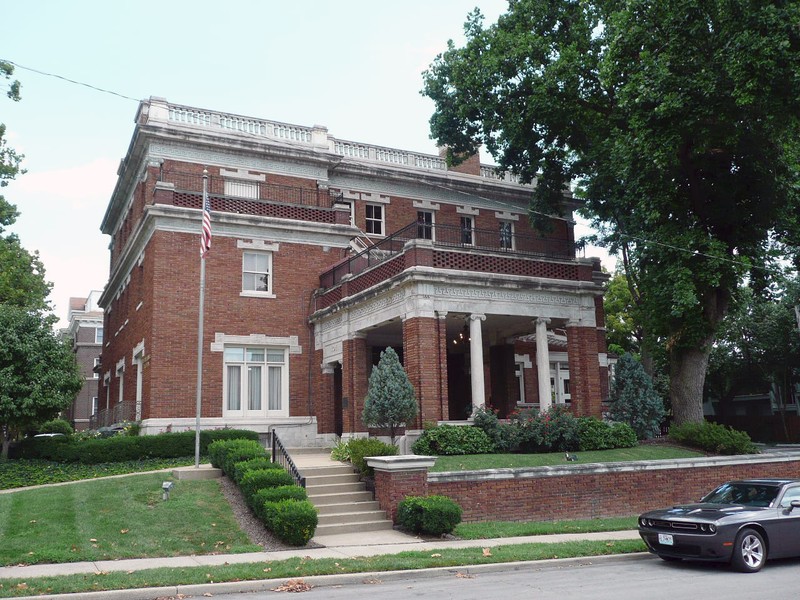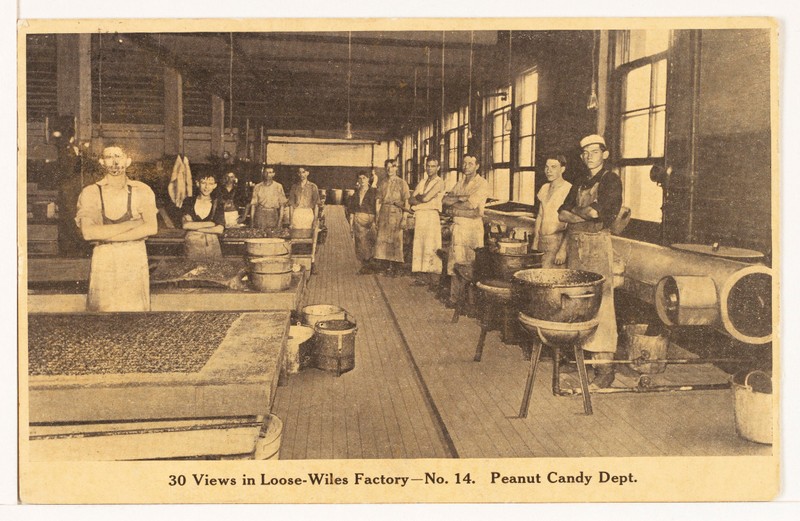Jacob and Ella Loose House (Loose Mansion)
Introduction
Text-to-speech Audio
Jacob Loose founded the Loose-Wiles Biscuit Company in 1902 and its massive success earned Jacob and Ella Loose a fortune, demonstrated by this four-story mansion that was built for the Loose family in 1911. Known eventually for its Sunshine Cracker products, the company introduced America to the Hydrox cookie, a chocolate and cream-filled sandwich cookie that predated the Oreo by roughly four years. The mansion cost several million dollars to build (2021 value) and included numerous elegant features, suitable for hosting hundreds of social elites and dignitaries at parties. The couple engaged in philanthropy including Ella's donation of nearly eighty acres to create Loose Park. Loose Mansion serves as an event space and bed and breakfast.
Images
Jacob and Ella Loose Mansion

Loose-Wiles Biscuit Company Peanut Candy Department

Backstory and Context
Text-to-speech Audio
Before there were Oreos, the Hydrox cookie emerged in 1908 as America's first cream-filled chocolate cookie, and it helped the Loose family amass a fortune and build a mansion. Jacob Loose founded the Loose-Wiles Biscuit company with its cracker snacks and cookies enjoyed resounding success for much of the twentieth century. Now mainly absorbed in the Keebler name, snacks like Cheez-Its survive as reminders of the once highly influential cracker business. The historic Loose property, completed in 1911, cost more than $7 million (2021 dollars) to build, and it stood as one of many grand homes located on Armour Boulevard.
Jacob Leander Loose and Ella Anne Clark (Loose) founded the Loose-Wiles Biscuit Company in 1902, making Sunshine Crackers. In 1946, the company officially changed its name to Sunshine Biscuit, Inc. Although the current Loose Family mansion website states the Sunshine name stemmed from Jacob's pet name for Ella (Sunshine), an alternative inspiration for the name involves the factory design that allowed for abundant sunlight. In 1912, the company built another sunlight-laden factory in New York referred to as the "Thousand Window" bakery in New York. The New York factory added to the brand's profound success and thus the Loose family's fortune as it operated as the world's largest bakery building until 1955.
The cracker business provided Jacob and Ella with enormous wealth. However, according to the modern-day Loose Mansion website, the construction of this mansion was the result of a different investment. Jacob and his brother Joseph Loose supported a friend with an investment of $10,000, and when that friend discovered copper in the Northwest U.S., that discovery led to a $1 million return for each brother. When Jacob asked his wife Ella what she wanted to do with the money, she explained that she wanted to build a home in Kansas City worthy of entertaining.
Ella selected George Oakley Totten, an architect who produced several Washington legation buildings, to design the mansion of her dreams. The four-story structure took two years to complete, with construction finishing in 1911 and costing $250,000 (more than $7 million in 2021 dollars). The home included such lavish details as Tiffany-made bronze doors, seven fireplaces, stained glass windows, numerous works of art, a marble entrance hall, and hand-carved mahogany oak features. Ella hosted a host of dignitaries, including Queen Marie of Romania and General Anaando Diax of Italy.
Jacob, a noted philanthropist, started the Children's Mercy Hospital's endowment fund with $25,000 in 1913 (equal to more than $680,000 in 2021). Ella, meanwhile, supported several causes, especially those supporting children's welfare initiatives (Ella lost two children as infants). For example, for more than thirty years, she purchased shoes for kids at her favorite orphanage. In 1927, four years after Jacob's death, Ella donated a life-size statue of Jacob and almost eighty acres to the city that became Loose Park. The park property once existed as a significant Civil War battleground where nearly 30,000 Confederate and Union soldiers clashed; the Union forces wound the battle soundly.
By the time Jacob died, the Sunshine Biscuit company had done an annual business of $40 million (more than $600 million in 2021 dollars). In 1929, Ella sold the mansion to the American Savings Life Insurance Co (later part of Texas Insurance Co) and moved into the ninth floor of the new Walnuts, which overlooked the park she donated to the city. Although her love for entertaining and her passion for living among the Washington D.C. elites mainly kept her in the nation's capital. She gained a reputation as a wealthy widow who regularly hosted parties and donated to various causes; she routinely visited the White House and hosted government dignitaries at her parties.
When Ella died, she left the bulk of her estate to the Million Dollar Charity Fund, Kansas City's first $1 million foundation. The park and the mansion remain, with the mansion now operating as an elegant space for weddings and events. There is also a Bread & Breakfast in the old Carriage House which was a former home to the Loose Family's staff. The seventy-four-acre park continues to serve the community, and there are numerous landmarks in the park that are included in Clio (links at the end of this entry).
Cite This Entry
Admin, Clio, David J. Trowbridge, and Mathew Powers. "Jacob and Ella Loose House (Loose Mansion)." Clio: Your Guide to History. August 27, 2022. Accessed August 20, 2025. https://theclio.com/tour/2016/7
Sources
Inflation Calculator. https://www.in2013dollars.com/
Loose Mansion Website. https://www.loosemansion.com/
Magerl, Barbara. "The Pendergast Years, Kansas City in the Jazz Age & Great Depression: Jacob L. And Ella C. Loose." The Kansas City Public Library. pendergastkc.org. Accessed August 9, 2021. https://pendergastkc.org/article/biography/jacob-l-and-ella-c-loose.
Uguccioni, Ellen J . "Nomination Form: Jacob Loose Mansion." National Register of Historic Places. archives.gov. 1983. https://catalog.archives.gov/OpaAPI/media/63817549/content/electronic-records/rg-079/NPS_MO/83001008.pdf
Wiki house photo By Mwkruse - Own work, CC BY-SA 3.0, https://commons.wikimedia.org/w/index.php?curid=42355636
https://kchistory.org/islandora/object/kchistory%3A108576

